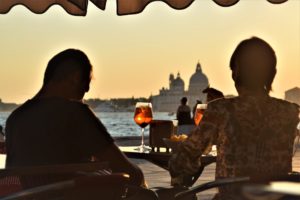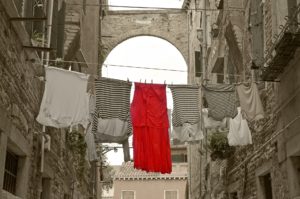A short guide fit for discovering the city
The following itineraries have been conceived to help you when you go sightseeing through the best -known part of the city, but also the most mysterious ones.
1 st itinerary through Sestiere di Cannaregio.
Station of Santa Lucia. You go past the church of Santa Maria di Nazaret or degli Scalzi, a baroque masterpiece of Baldassare Longhena. It was started in 1672 and consacrated in 1705. There go on along Rio Terrà Lista di Spagna as far as Campo San Geremia. You will see Palace Labia, a patrician residence of the 8 th century with frescoes by G.B: Tiepolo and the Church dedicated to San Geremia and Santa Lucia.
Ponte delle Guglie, before crossing it, fondamenta on the left, there is an entrance to the public park Savorgnan. If you go on along the fondamenta, you get to the Ponte dei Tre Archi, inaugurated in 1580 and unique as to its structure. Beyond the bridge you will see the Church of San Giobbe, one of the earliest examples of Renaissance architecture in Venice. In its sacristy there are original wardrobes of the XVI century and a triptich by Vivarini.
The last sotoportego of the fondamenta offers the sight of Baia del Re. It is an area built in the early years of the 20 th century with salt marshes where the largest complex of popular houses exposed to the north of the lagoon at the mercy of the wind and the cold. That is why it was called Baia del Re as it can be compared to the cold that, in the early years of the 20 th century, General Umberto Nobile had to face in the Baia del Re in the Swalbard Islands, the base camp of his unlucky expedition to the North Pole. You will see two beautiful wooden bridges, fully made of wood and iron.
If you cross Ponte dei Tre Archi and there you turn right, reverse the fondamenta on the opposite side of Rio di Cannaregio. Past the Gam Gam Restaurant you get to the sotoportego leading to Campo Ghetto Vecchio and Campo Ghetto Nuovo, the most ancient Jewish ghetto in the world. Cross the bridge and turn right. There go on as far as Restaurant da Rioba and turn left. After crossing the channel you get to Church of Santa Maria dell’Orto in the gothic style, XIV century (Tintoretto was buried there and some of his worksare kept there) After reaching the Church of Abbazia della Misericordia and, you have to lead towards Strada Nova. From that Strada you get to Campo Santi Apostoli and Rialto.
Many more itineraries to discover the city step by step and not to lose its wonderful sights which dot the city are at your disposal.


